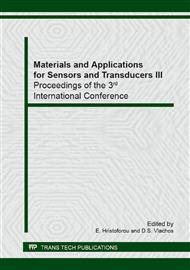p.360
p.364
p.368
p.372
p.376
p.380
p.384
p.388
p.392
Microstructure, Surface Characterization and Fatigue Assessment of 56SiCr7 Spring Steel
Abstract:
A high number of cycles sustained before failure, under cyclic loading application, is one of the key performance requirements of springs. Heat and surface treating of the spring steel can have a significant influence on its fatigue life. The main purpose of heat treating is to achieve a tempered-martensitic microstructure with appropriate surface hardness, in order to increase the fatigue limit of the spring. The heat treatment aims to an end martensitic formation from an initial ferritic/perlitic microstructure through the steps of heating, quenching and tempering. This study shows that the correct parameters chosen for each of these steps for 56SiCr7 steel can result to an appropriate microstructure, and therefore increase the steel surface hardness up to approximately 550-600 HV. With the aid of optical microscopy, the thickness of the decarburized surface layer is determined, in order to distinguish between the core and surface microstructure hardness of heat treated steel. Surface treatment, through shot-peening, induces compressive residual stresses on the surface of the steel, thus increasing the hardness by at least 204 HV, compared to the raw material, and doubling the number of cycles to failure. Vickers micro-hardness measurements conducted on a cross-section, at different depths from the surface of the steel, show the trend of hardness increasing towards its core, and verify the dependence of the surface hardness of the steel on heat treatment.
Info:
Periodical:
Pages:
376-379
Citation:
Online since:
April 2014
Price:
Сopyright:
© 2014 Trans Tech Publications Ltd. All Rights Reserved
Share:
Citation:


